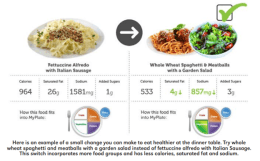Happy New Year! Do you usually make a New Year’s resolution? Millions of Americans make resolutions every January hoping to improve their health by losing weight, getting fit, or eating healthy. Achieve your nutrition goals this year by making small changes to what you eat and drink.
Find your healthy eating style
Everything you eat and drink over time matters. The right mix can help you be healthier now and in the future. It is important to start with small changes to make healthier choices you can enjoy and maintain for a lifetime. In order to get the nutrients and calories you need, eat a variety of foods regularly.
Get your MyPlate plan
Everybody requires a different amount of calories depending on their age, genders, height, weight, and physical activity level. To determine what and how much to eat within your appropriate calorie target, enter your information into the MyPlate Plan by U.S. Department of Agriculture (USDA) at https://www.myplate.gov/myplate-plan and receive a personalized plan.
Follow the MyPlate building blocks
- Make half of your plate fruits and vegetables
- Focus on whole fruits
- Vary your veggies
- Make half your grains whole grains
- Move to low-fat or fat-free milk or yogurt
- Vary your protein routine
- Drink and eat beverages and foods with less sodium, saturated fats, and added sugars.
- Drink water instead of sugary drinks.

Find small changes that work for you throughout the day. Don’t forget to choose foods and beverages from each MyPlate food group (i.e. fruits, vegetables, grains, protein, and dairy) for a balanced meal.
Tags: Nutrition, Healthy Eating, Health, Fruits and Vegetables
Source: MyPlate.gov
By: Jamie Rathbun
 It’s never too early to start planning your garden and landscape! Join Post Rock and River Valley Extension to learn how to make your landscape stand out this spring.
It’s never too early to start planning your garden and landscape! Join Post Rock and River Valley Extension to learn how to make your landscape stand out this spring. Or scan this QR code with your smartphone’s camera:
Or scan this QR code with your smartphone’s camera:
 Having a well-stocked kitchen makes meal planning easier. Use this basic food checklist for some ideas to help stock your pantry, refrigerator, and freezer for simple meals. Feel free to personalize this list with foods you frequently use.
Having a well-stocked kitchen makes meal planning easier. Use this basic food checklist for some ideas to help stock your pantry, refrigerator, and freezer for simple meals. Feel free to personalize this list with foods you frequently use. K-State Garden Hour is ready to kick off the season with some fun, educational programs. The first webinar will be on Wednesday- January 4th, 2023. Reno County Horticulture Extension Agent, Pam Paulsen will discuss Gardening Myths and Misconceptions.
K-State Garden Hour is ready to kick off the season with some fun, educational programs. The first webinar will be on Wednesday- January 4th, 2023. Reno County Horticulture Extension Agent, Pam Paulsen will discuss Gardening Myths and Misconceptions.

